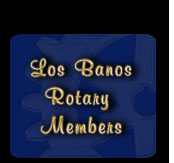




Los
Banos Rotary Club History
Merrill Compliments Los Banos Spring Fair
Hailing the Merced County Spring Fair and May Day in Los Banos celebration as an outstanding example of specialized California Fair that is accomplishing its basic purpose of promoting and developing dairying and livestock farming in this state, at the same time providing outstanding entertainment facilities for the people of the community, Lou Merrill, Sacramento, in talks made in Los Banos this week, complimented the people and leaders of the community for providing a community festival of such high caliber, Merrill is general manager of Western Fairs Associate.
Merrill spoke to two civic groups here Tuesday, the Rotary Club at noon and the Lions Club in the evening. In both talks he emphasized the point that the local fair and livestock show is a part of California's great system of Fairs and Festivals that is partially supported with state funds derived from the tax collected on pari-mutuel betting at horse races. California's law provides that 86 ¼ cents of each $1.00 bet at the races be returned to winning ticket holders; 8 ¼ cents goes for track expenses, and 5 ½ cents goes to the state, from which 2 ½ cents is allotted to fairs for premiums and operation, plus money allotted for buildings and other property.
There are 79 such fairs in the state today, with property assets (belonging to the public) estimated at $84,250,000. Last year total attendance at these fairs totaled 6,140,142 people.
Cash awards paid exhibitors of over a half million separate entries for encouragement of a high standard of perfection last year equaled less than 1-10th of one per cent of the state's 2 ½ billion dollar cash farm crops. Indicative of the value of such demonstration of quality, Merrill pointed out that California has but 2 ½ per cent of the nation's farms, but has 8 per cent of the nation's farm income. This indicates, he said, the value of competitive improvement, partially made possible by the state's apportionment in addition to local support.
Merrill also stressed the educational value of fairs to the coming generation of California's farmers who are encouraged in their dairy and farm projects by junior division fair awards; also the support given California State Polytechnic College, which has received some $26 million in horse racing revenue. The University of California is the greatest benefactor of horse racing funds, having received some $29 million since the pari-mutuel horse racing law was enacted in 1934. The university has used the money primarily in a long range program to improve the facilities and broaden the activities of the agricultural science divisions.
Locally, Merrill said, the Spring Fair has now received more than $685,000 from pari-mutuel funds, a portion of which has been paid out in premiums and prize money and the remainder spent in building our Fairgrounds Park facilities.
Analyzing the answers received in a statewide survey conducted to determine the public's reaction and thinking of fairs and festivals, Merrill said the average family of 2.9 persons, last year spent $6.66 at fairs, traveled an average of 24 miles from home, spent 5 ¼ hours at the fair, and that 32 per cent of fair goers were under 21 years old. Why? The report showed 58 per cent were educationally minded, taking advantage of the opportunity to learn of new things and new methods to make their lives better. Thirteen per cent attended as a matter of habit, and the rest primarily so they could take the children.
Floral and garden displays headed the list of attractions, followed closely by commercial and livestock exhibits, entertainment and carnival attractions. Surprisingly, horse racing, which accounts for the major part of state support, rates next to last as an attraction feature.
Merrill warned that metropolitan centers do not have the interest in or recognize the value of fairs as do the people of the rural areas, and that their representatives in state government often seek to divert the horse racing tax money to other purposes. Senators and assemblymen from the rural areas, he declared, must be ever vigilant to protect this fund and thus insure the continuance of the state's fair program.
Merrill was introduced by Frank Peluso, manager of the New Sonoma Creamery.
At the Rotary Club luncheon, Henry Bove, local barber, was officially welcomed into the club as a new member, with Paul Benz making the membership presentation.
Rotary President Jess Telles announced there would be no Rotary Club meeting next week.
March 25, 1955
Los Banos Enterprise, Rotary Club 585 & Memorable Places Web Design of Los Banos


